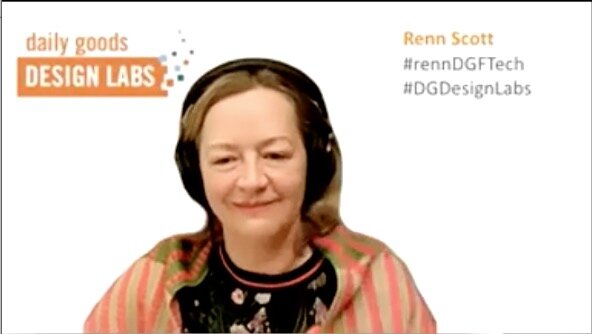Women Make Create and Innovate at DesignTO 2021
Thesis App by Veda Adnani Chatterjee
The image on the app looked like the younger, hipper, sister version of Sanderson’s Dandelion Clocks print, with each dot representing a day in a woman’s cycle.
The audience reaction was immediate.
The chatroom exploded with excitement as the panelist revealed her prototype at the latest Women Who Make, Create and Innovate event during the 2021 DesignTO Festival. No twee pinks and fey pastels in sight. It was discrete, beautiful, user-friendly and super-functional - this is what design by women, for women, is all about.
Women designing for women was the focus of the event in which DGDL founder Renn Scott, mediated the STEM-savvy panel and encouraged audience participation throughout. She started the event off with an overview of trends in female-based design which highlighted that inclusiveness and adaptive design is at the forefront of innovations in this arena.
The first panelist, Adriana Ieraci, CEO and founder of product and service design firm Conveyor Built, discussed why it is important to design healthcare with women at the heart of innovations focusing largely on the impact of Covid-19 and how much of the care-giving has fallen on women. She cited many examples that stayed with the audience, such as one from her colleague Dr Jane Batt, whose research found that if a women 66+ years of age is immobile in hospital for over a fortnight, she has only a 50% chance of returning to an independent life, ie. being able to wash and feed herself.
Adriana believes it is crucial that health care solutions be ‘lean and agile’ - specific to a woman’s physiology and needs - which most research and design today isn’t taking into account. A complex network is required to be part of the HealthTech solution, from medical staff, to care-givers, to bureaucratic partners and more.
While Adriana tackled the bigger picture, our second panelist, Veda Adnani Chatterjee, brought this idea home with her targeted examples, like the one described in our intro. Veda, the UX Design Lead at Myant Inc and FemTech researcher, described the oversights in existing period-tracking apps, “There is very limited hardware innovation. They are often too pink or floral. They don’t take into consideration same-sex couples or women who are not comfortable using these experiences, and other critical life events such as miscarriages. Thus, offending a lot of users in the process.”
She asks, “What does it mean to feminize and experience, I don’t think making it pink does that.” Her prototype takes into account that women have outside life criteria that impact on, or are impacted upon by their menses. For example, why shouldn’t your period-tracker sync with your diary so you don’t plan back-to-back meetings on the days that are sub-optimal for you?
Veda also brought up the issue of representation and equal status in research. She recommends Caroline Criado Perez’s book Invisible Women to understand the data gaps in female representation that impacts on design (within medical research), especially regarding race and diversity. “We just want to see the data and we want equal access,” she says.
The big question for her is how to develop a framework for design of digital health tools that empowers women in ways that are thoughtful, intelligent, inclusive and responsible?
Final panelist, Kem-Lauren Kramer, founder of iNNOVATION Life Labs, took the diversity in design question a step further: how might we design for humanity? She believes all bias issues can be grouped and can be resolved by looking at three main categories: Sustainability, Ethicalness, and Diversity. She cited deep-seeded biases in examples like in 2019 when NASA hadn’t designed space-suits with women in mind; Dr Timnit Gebrhu who was fired from Google for refusing to edit her research flagging the algorithmic bias in their software; and Canadian AI researcher, Dr Joy Buolamwini who has found biases in facial recognition software - it has difficulties recognizing the smaller features of women and darker skinned faces.
Kem says empathy - being able to put yourself in the shoes of all humanity - is important to replace the silo-ed questions and rhetorical biases that are currently informing design. Coming from a farming family herself, she sees that there is an underlying materialism in current design that doesn’t consider how it impacts third-world countries and our environment as a whole. She believes we need to guide and advocate for humanity in design, especially in this crucial period of design history.
The evening wrapped-up with a round of excellent audience discussions including the need to eradicate pink-taxed products; how care-givers in Covid (mostly women) are changing the landscape of product and services; and how to design for wide representation, when you are the only female designer at the table.
Much more time was needed to cover all the exciting findings and information points, so we will be planning a series of future events to evolve the discussion. Our next online event, 'Women, Wearables and Healthcare', will be part of the Woman’s Day 2021 celebrations. It will continue the discussion started here and is scheduled for March 10th, 3-5pm. For registration information follow us on Twitter and Instagram or check our Events page, later this month. Men and gender-non-binary participants are also welcome and encouraged to join in and support.








